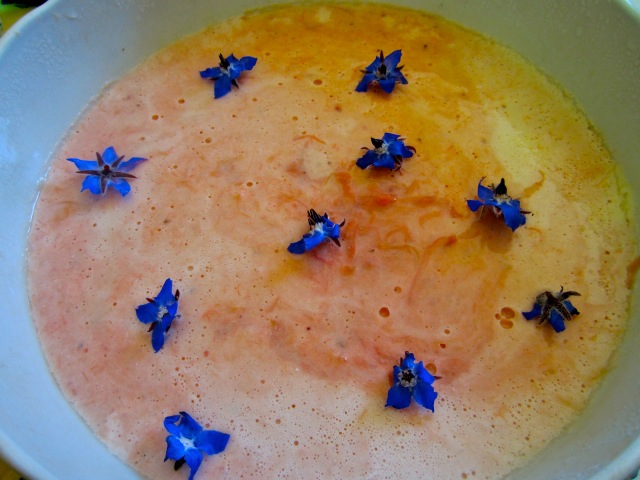From Field to Fork
Posts about farm living
Strawberries in June

Strawberries are Ripe.
If I was to have another jab under the jacket of the government I see them in my mind’s eye zooming around their screens in search of the national unlocking with ‘a little bit here and a little bit there’ while trying to hold unrest and disruption in check. What they can’t control is the weather and the changing the English temperament.
They started with the garden centers, insane on the one hand and brilliant on the other. For anyone with a garden and wanting to DO something, getting dug in would ease off pressure like a slow puncture in a bicycle tire. What next? Shopping. Who knew how many people shop for shopping’s sake ?
Now something for the Yobs and the Snobs, to be unkind – which I will try not to be. Street markets. Stalls opened up, shops became markets and the Camden Market, just newly renovated last year, is open for business along with the Farmer’s Markets.
Primrose Hill Market opened up three weeks ago. Nope – not going on the first week. The second week we joined the long queue that shuffled along both sides of Primrose Hill, everyone making an effort at social distancing. The market was sparse, war weary, and I wanted to buy something from everyone just to help them feel it was worth the effort.
Mid-morning on week three we return. The day is blustery as if spring is pouting into summer. There is no queue. We are welcomed by the volunteers and the sweet young thing who is trying to sell her own mixture of hand sanitizer at the gate. But at £ 5.00 a bottle it’s pricey. “How do you like the smell?” “It’s very nice.” But I don’t add at this point that I don’t care how my hands smell from sanitizer. The market looks a little better as if a week’s rest has helped. But there are still big holes where stalls used to be. Where is farmer Geoff and his vegetables and eggs from Canterbury, the fishmonger from Poole, the local London honey and the wonderful Italian Pasta ladies? Even jolly Tony has sent a younger man from his dairy. For some market stalls this has been a swift axe blow, others are in hibernation, licking wounds inflicted by the virus induced lockdown. Vegetables are rotting in fields, but livestock still needs care, growth and slaughter. The two butchers are here and I shop from one.
And so is Carlo from the organic fruit farm in Kent where the soft berries are bursting on their vines and the ripe cherries dripping from the trees. Carlo has brought them all. He is a fast-talking, fast-working Eastern European who has an ease of knowing and selling that makes me wonder where he came from. Was he raised on a farm? Did his grandmother and mother want the same fruit that I do? For he has my strawberries. The berries that do not make the grade for elegant strawberries tarts or the Wimbledon tennis parties that are not happening this year, the little ones, odd shaped and more deeply flavorful from having been left in the field a little longer, in the hopes that they would turn into something prettier. Carlo knows that I want mine for jam and he has set aside – for ladies of a certain age – a few punnets of these berries. He tips three into a bag for me and I add some cherries for a morning coffee treat.
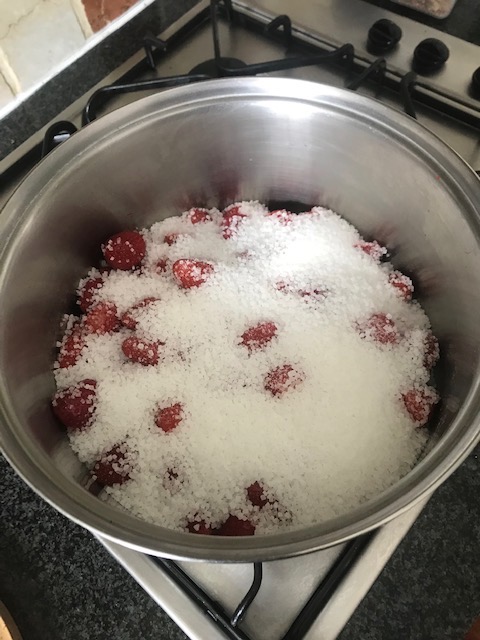
Standing at the sink and hulling the berries is soothing. The berries are small and flavorful and as I started them right away there are only three to be taste tested. Into the pan they go, layered with preserving sugar that is available for those of us who still do such things and a younger generation replaying their childhood memories and making new ones for their own families.
As children, out from boarding school for Sunday lunch, we would be sent ‘into the garden to see if you can find some berries,’ Did we ever. We had a huge bed of strawberries in the kitchen garden. Covered in high netting so that the gardener could walk through, the plants laid on fresh straw that reflected the sunlight and kept the berries clean. But first there were birds who had been caught in the netting to capture, and set free, before eating all the berries we picked before lunch which, of course, included strawberries and home made ice cream.

But now there are just the two of us in a little cottage in London to enjoy the fresh berries and make a little jam. After coffee the strawberries are hulled and layered together with the preserving sugar all smelling so sweet, a check that we have not lost our sense of smell. They will slowly absorb the sugar for 24 hours before I turn the heat on to bring it all to a rolling boil.
In the farm kitchen there is a jar full of spoons and one is ‘the jam spoon’ that over the years has been honed into shape, one side growing straighter from stirring and lifting to see the two drops come together as one and tell me that the jam or jelly is done. I have only one long-handled wooden spoon in the cottage and over time this too is beginning to change as the drops form with promise of the gifts that are to come.

This has been a Letter from A. Broad.
Written and read for you by Muriel Murch
Harvesting the Hill
First aired on KWMR.org May 20 2020
‘It’s a Debortle’ became the catch phrase for any minor/major hiccup that occurred during the post-production of Coup 53. A blazer-clad and panama-hatted Brit arriving back in England from Iran was caught on camera and asked to describe the exodus of the British from Abadan in 1951. The journalists surrounding him didn’t seem to notice his grin as he repeated ‘Debortle’ while not giving any hint of the word’s origin. ‘It’s a Debortle,’ became the cry and the tee-shirt slogan for Coup 53 and in more than one London household referencing the situation we are all in, around the world.
The UK government’s handling of the Corona19 epidemic in England has been a debortle. But watching the medical staff at the Saint-Pierre Hospital in Brussels, Belgium as they silently turned their backs on Prime minister Sophie Wilmes when she arrived to visit, we see that England is not alone. Countries all over Europe, and continents throughout the world continue to struggle with this itsy-bitsy virus that maybe is here to teach us some sort of a lesson.
Even though this government says we can begin to venture out, as long as we ‘Stay Alert’, like many others we continue to stay alone at home. Guidelines from the “Evenin’ Standud”, dropped on our doormat nightly, continues to say that as over 70 years old we are among the extremely vulnerable. We turn to this guide rather than the three blind men (and women) who at 5 p.m. each weekday night stride out to their podiums at number 10 Downing Street with the day’s rule changes. Barely one thing they say is reliable and by morning it often needs amending – again.
So we stay at home and face each morning’s question–what to wear today? If one is lucky there is someone else in the house who can smile at you looking neat or lovely. But maybe there isn’t, and just the effort of getting dressed can sometimes be too much. But there could be a delivery. A loud knocking on the door in the morning has me racing – carefully – downstairs, but the postman is already leaving before I can open the door. I shout a “Thank you” with a smiling wave and he turns with his happy smile and wave in reply, but is already striding across the parking lot and I don’t think he can notice what I am wearing.
At some point during the day, separately or together, we will go to the park, down by the canal or around the hill. The end of spring has begun to layer white across the green before the summer pinks, blues and purples come to paint the summer hedgerows. There is a tall wall around the bottom perimeter of Primrose Hill. Houses, blocks of flats and even a reservoir are closed off. But from back gardens and small alleyways there are old wooden gates in the wall. The delight in a road or a pathway leading forward never fades. This feature is found in city and country parks all over, and surely must have been a thought for the American writer Frances Hodgson Burnett when she wrote ‘The Secret Garden’ published in 1911.
Now swaths of Cowslips that grew thigh high under the lime trees are beginning to soften from their bright white, while the Elderflower shrubs stand tall and take their turn, gracefully to unfurl their florets. It is too much! and carrying a floppy old plastic bag holding my clippers I walk the perimeter of the hill, eyeing the Elderflower heads as they bow towards me. It is a slow walk, for I must gauge how low the flower heads are, and glance around to see if anyone is watching. If I walk too deeply into the underbrush I may disturb someones lodging. There are only a few signs of human habitation but there are enough to remind me to be respectful. I’m looking for 20 to 30 full flowering heads from the Elderflower shrubs. Being particular, it takes walking the mile perimeter to gather what I need. Then I can saunter on home and pop the bag in the fridge to stay fresh until I have everything ready.

Recipe
Our next door neighbors are also self-isolating. They have returned to London from their years in the Irish countryside. Like us, a smaller home and the lure of grandchildren has brought them back to the city. And, like me, they have brought their country recipes with them. Ros emails me a well-stained 40 plus year-old copy of her recipe for Elderflower Cordial.
Time is 26 hours total if you count harvest and preparation.

Once bottled and chilled it is immediately delicious. It is a perfect summer drink and my evening glass is going down a treat. The sun is shining this week, and we are very grateful to be allowed back onto our terrace. We were definitely “personae non grata” outside while the Blue Tits began nest building and egg incubation. But now the eggs have hatched and the parents are too busy flying in and out of the nesting box above the Vanessa Bell and Sir Walter Scott Roses to be too nervous about us. Bill Oddie’s bird book says they can hatch 14 eggs but I don’t see how they can all fit in the box. Maybe I will just have come out each evening, sip a little more cordial and count until the one night they all fly away.
This has been A Letter from A. Broad, Written and read for you by Muriel Murch.
Wilding: A conversation with Isabella Tree
Ways of Wilding.
Sweeping in from the Atlantic Ocean, crossing over England, Wales and into Europe, storm Dennis came on the heels of storm Ciara while storm Ellen is due in this weekend. The TV news no longer leads with stories of Middle Eastern war, disgraced public figures nor even upset politicians but shows aerial views of flooding and interviews with families and farmers absorbing the devastation to their homes and farmland.
Walking down our street at dusk, I hear the robin calling as she goes to roost in the Silver Birch tree outside our cottage.

Robin Red Breast
She, the finches, tits, blackbirds and pigeons are all engaged in the business of city living. It is the same in the countryside, where animals and birds move around us, making the best of a not-so-good-job. But there are some places around the world and now in the UK where we humans have given way, admittedly mostly out of necessity, and are returning the land to those who were here before us.
One such place is the Knepp Farm in West Sussex. After years of intensive farming the Burrell family came to accept that modern farming methods on such heavy clay soil would never be fruitful. They began to wonder what would happen if … ? and then set out to record it. Isabella Tree’s book ‘Wilding The Return of Nature to a British Farm’ is the result. When first published in 2018 the book caused quite a stir. And Tree continues to stir, writing articles and giving talks wherever an audience is to be found. There are naysayers of course, and some of my dearest old farming friends in England are among them. But there is thought, and outcome, and more people willing to wonder ‘what if we …?’ The changes in the land, the flora and fauna and their habitat that has returned is already visible. So there is excitement and encouragement and a willingness to search out ways that we who care for such things can carry on, sharing and yet returning the land to those creatures to whom it first belonged.
This interview with Isabella Tree was recorded at Knepp Castle in August 2019. We took the train to West Sussex and, with equipment borrowed from Amirani Media, Isabella Tree and I sat down for an hour while she shared her passion, findings and hopes for the future of farming in the UK. The program was aired in September on KWMR.org the day before Isabella Tree spoke at the Point Reyes Book Store in Point Reyes Station, California.
During the last two weeks that England has been battered by two storms, one on top of the other the flooding damage to many towns and farms still continues. Strangely though, in West Sussex, where the county councils have incorporated some of the principles of Wilding in water management the damage has been considerably less. In Devon where beavers escaped into the River Otter and now in Cornwall where both Wildlife Trusts are monitoring the beavers’ behaviors, the creation of beaver lodges and dams has been seen to slow water runoff and thus lessening storm damage. Maybe there is something to letting nature take her course, and us our cue from her as we work and farm mindfully within her embrace.

Charlie – Just checking
On our little city terrace, we share space with those who come to call. In the mornings we feed the small birds who, sensibly, have not begun to nest quite yet. At night, ready to turn out the kitchen light I look out the window and see our Charlie, a big urban fox, doing his rounds. I like to think that they, all creatures great and small, are ready to help us if we could only find our way to let them.
Filling out Farm Forms
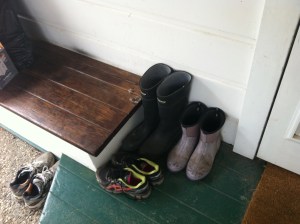
Boot bench
It must have been around 1976, a few years after we had settled into The Old Dairy. We had been checked out, evaluated and in town long enough and been seen to be trying to do right by the land and thus we were assigned our place in the community.
The pantry shelves had not yet become cupboards but the old kitchen sink was installed in the tack room. A bench and a picnic table were nestled into that kitchen space now turned into a ‘nook’.
The bench and table wood was new and shiny and must have been purchased in a rebellious extravagant moment. The benches are long removed, one has disappeared all together while the other has become the ‘back-door-boot-bench’.
The table remains, now taking center stage in a proper sized farm kitchen. Here we break bread and ponder the woes and joys of our family and community lives. But then, in the second half of the 1970’s, these ruminations all took place in the nook.
Jess must have waited and thought about it for awhile. Maybe it was while mulling over his predicament with a cup of coffee and his know-everybody-and-their-business sister-in-law Lydia that she suggested, ‘Try Aggie, down at the Peter’s place.’ For it was still too early to be known as Blackberry Farm, the name we had given The Old Dairy when we arrived. Jess, like many old ranchers of Sonoma and Marin had a little side line in horses. Working ranch quarter horses were mostly home bred but sometimes one could get lucky and dabble in a little thoroughbred breeding for the track. Heck, it didn’t cost much and was a little more fun than raising the steers for market. But the young colts and fillies had to be registered before they were yearling.
This could pose a problem for the old cowboys of Santa Rosa and ranchers of Marin and Sonoma. Most of them had dipped into grade school but many had slipped out when fathers with ranch chores needed help. It may have been thus for Jess. Then, as now, the extent of one’s book learning ever needs to be kept a secret from ones increasingly educated children. Parents then were frustrated and resented, as much as we do now, having to admit our failings with the written word and computer technology.
It was mid-afternoon when the old green chevy truck pulled up in the driveway. At first I didn’t recognize Jess, mostly because he was rarely seen off the ranch or out of his truck. He knocked, as we all do, on the back door.
What did he say in greeting? I don’t remember, the usual, ‘Howdy,’ I expect before we sat down at the table in the nook. Jess reached into the inside pocket of his worn, thick Levi jacket and produced the crumbled forms he needed to fill out in order to register the yearlings. The forms were easy for me, simple and straightforward like a birth certificate should be. Jess had chosen names for the yearlings that we wrote down. The job was soon done and I handed the forms back to Jess. He nodded his thanks and we took a little longer, lingering over a cup of coffee, to talk of breeding, the weather and crops before he rose to leave. I didn’t see him again until 1995 at Mary Magdalene Church when he tolled the tower bell calling Lydia home to rest.
Since that time forms have become a growing crop for farmers.As organic farming becomes a business there are organizations to monitor and check up on us, our fields and our crops.

Must be here somewhere
Like most busy country people my forms get shuffled about and sometimes misplaced so that due dates come rushing towards me.
Now I’ve opened the envelope to another one. The due date, May 7th is past. But I still don’t know or understand what the form is for, why it is necessary or what they want from me. Where to, and where not to, fill it out?
I’ve been thinking about it for too many days now. Maybe it is time for me to get on my bike, ride down the road, and check in with the young farmer by the creek. He seems to know what he is doing.
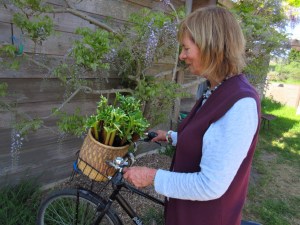
Time to get on my bike to the young farmer down the road.
Sorrel Soup
Sorrel is an early, easy leafy green vegetable to plant in the perennial vegetable garden.
Garden sorrel or Rumex Acetosa and French Sorrel Rumex Scutatus both have a tangy lemon flavour. I’m not sure which one I am growing but it may be the French because of its pointed leaves. Sorrel looks like its weedy first cousin wild Dock but is a brighter, springier green. They all look a bit scruffy but are equally useful. Sorrel for soup and salad and Dock (with a bit of spit) to calm a stinging nettle rash when you are out walking.
This recipe is adapted from one given to me by my friend Creta Pullen. Creta, her husband Bill, and their two very enthusiastic dogs run Ocean Song Retreat Bed and Breakfast. Creta is an outrageous cook and always concocting something new. It was Creta who gave me my Sorrel starts.

Blended sorrel soup on the stove.
- Cut a bunch/handful of Sorrel.
- Wash and sort it and set it in a jar until you are ready to use it.
- Sauté a chopped onion or leek or shallot in olive oil.
- Today I added a little fresh chopped ginger and some turmeric and 4 bay leaves.
- Stir to colour and soften while dicing up a Russet potato and
chopping 2 carrots. - Now add these to the onions and stir some more.
- Any white wine in the fridge? A glug or two can go in now.
- After the wine is absorbed add your home made chicken or vegetable stock.
(There will be more on making stock later).
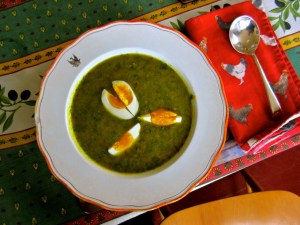
Ready to serve sorrel soup with a hard boiled egg.
- Let it all cook up gently until the carrots and potatoes are tender.
- Strip the sorrel leaves from their stems and roughly cut up the leaves.
- While the stock cools do something else (lay the table, boil an egg or two).
- Fish out the bay leaves and put them in the compost.
- Now with whatever blender technique you use, blend the soup and sorrel leaves together. Return to the pot and adjust the seasoning. I add a little pepper here but no salt.
- Now it is time to add your own favorites. A little milk or cream or butter will soften the flavor. Tonight I made soft boiled eggs.
- Some warm French bread, a glass of wine and supper is yours and goes down a treat.
Rhubarb-Strawberry Mousse
This recipe first appeared in The Times in an article by Olwen Woodier in 1989 I think. Sometime later it was adapted from Mallards Restaurant at Arrowwood in Rye Brook, N.Y.
- Combine the rhubarb, strawberries and sugar in a heavy 2-quart saucepan and simmer for 20 minutes, until the rhubarb is soft.
- Pour 2/3 of the mixture into a blender with the kirsch; purée and set aside.
- Pour 4 tablespoons cold water into a small saucepan and sprinkle the gelatin over the top. Allow to soften for 10 minutes. Heat gently until the gelatin has completely dissolved. Stir into the rhubarb purée.
- Combine the purée with the remaining cooked rhubarb mixture.
- Whip the heavy cream until stiff and fold into the rhubarb mixture. Chill for several hours. Serves 8 to 10.

